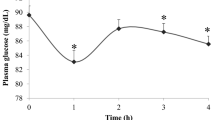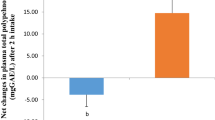Abstract
The aim of this study was to examine the postprandial impact of raisin supplementation in serum resistance to oxidation of healthy subjects, to quantify the bioavailable phenolic compounds and oleanolic acid. The content of phytochemicals in raisins was determined by GC-MS. Fifteen healthy volunteers who consumed 144 g of raisins were subjected to blood collection at time 0 and 1, 2, 3 and 4 h after consumption. Blood samples were used for the quantification of (a) serum oxidizability (b) plasma total polyphenol content and (c) phenolic compounds and oleanolic acid by applying GC–MS analysis. A total of 25 phytochemicals were identified and quantified in raisins, while the triterpenoid oleanolic acid was present at the highest concentration. The peak of plasma total phenolics and serum oxidation resistance appeared 1 h after raisin supplementation (p < 0.05) and correlated strongly with each other. Seventeen phytochemicals (16 phenolics and oleanolic acid) were clearly identified and quantified in volunteers’ plasma. Each compound followed different kinetics, however 13 out of 17 peaked in plasma also 1 h after supplementation. The results indicate that raisins influence antioxidant potential in vivo, while the contained phytochemicals are bioavailable.
Similar content being viewed by others
Abbreviations
- BSTFA:
-
Bis-(trimethylsilyl)-trifluoro-acetamide
- GC-MS:
-
Gas chromatography–mass spectrometry
- IS:
-
Internal standard
- PBS:
-
Phosphate-buffered solution
- RT:
-
Retention time
- SPE:
-
Solid phase extraction
- GAE:
-
Gallic acid equivalents
References
Arts IC, Hollman PC (2005) Polyphenols and disease risk in epidemiologic studies. Am J Clin Nutr 81:317S–325S
Blasa M, Gennari L, Angelino D, Ninfali P (2010) Fruit and vegetable antioxidants in health. In: Watson RR, Preedy VR (eds) Bioactive foods in promoting health, 1st edn. Elsevier, London, pp 37–58
Bennett LE, Jegasothy H, Konczak I et al (2011) Total polyphenolics and anti-oxidant properties of selected dried fruits and relationships to drying conditions. J Funct Foods 3:115–124
Karadeniz F, Durst RW, Wrolstad RE (2000) Polyphenolic composition of raisins. J Agric Food Chem 48:5343–5350
Chiou A, Karathanos VT, Mylona A et al (2007) Currants (Vitis vinifera L.) content of simple phenolics and antioxidant activity. Food Chem 102:516–522
Arendt BM, Ellinger S, Kekic K et al (2005) Single and repeated moderate consumption of native or dealcoholized red wine show different effects on antioxidant parameters in blood and DNA strand breaks in peripheral leukocytes in healthy volunteers: a randomized controlled trial (ISRCTN68505294). Nutr J 4:33
Aurrekoetxea I, Ruiz-Sanz JI, del Agua AR et al (2010) Serum oxidizability and antioxidant status in patients undergoing in vitro fertilization. Fertil Steril 94:1279–1286
Esterbauer H, Jurgens G (1993) Mechanistic and genetic aspects of susceptibility of LDL to oxidation. Curr Opin Lipidol 4:114–124
Shahrzad S, Bitsch I (1998) Determination of gallic acid and its metabolites in human plasma and urine by high-performance liquid chromatography. J Chromatogr B Biomed Sci Appl 705:87–95
Soleas GJ, Diamandis EP, Karumanchiri A, Goldberg DM (1997) A multiresidue derivatization gas chromatographic assay for fifteen phenolic constituents with mass selective detection. Anal Chem 69:4405–4409
Bunea CI, Pop N, Babeş AC et al (2012) Carotenoids, total polyphenols and antioxidant activity of grapes (Vitis vinifera) cultivated in organic and conventional systems. Chem Cent J 6:66
Chiva-Blanch G, Visioli F (2012) Polyphenols and health: moving beyond antioxidants. J Berry Res 2:63–71. doi:10.3233/JBR-2012-028
Heuckenkamp PU, Zollner N (1971) Fructose-induced hyperuricaemia. Lancet 1:808–809
Schirrmacher G, Skurk T, Hauner H, Graßmann J (2010) Effect of Spinacia oleraceae L. and Perilla frutescens L. on antioxidants and lipid peroxidation in an intervention study in healthy individuals. Plant Foods Hum Nutr 65:71–76
Kanellos PT (2009) Determination of vitamins in Corinthian currants. BSc Thesis, Harokopio University, (in Greek)
USDA National Nutrient Database for Standard Reference, Release 25 http://www.ars.usda.gov/Services/docs.htm?docid=8964 (Accessed March 10, 2013)
Niki E (2011) Antioxidant capacity: which capacity and how to assess it? J Berry Res 1:169–176. doi:10.3233/JBR-2011-018
Niki E (2012) Do antioxidants impair signaling by reactive oxygen species and lipid oxidation products? FEBS Lett 586:3767–3770
Pérez-Jiménez J, Serrano J, Tabernero M et al (2009) Bioavailability of phenolic antioxidants associated with dietary fiber: plasma antioxidant capacity after acute and long-term intake in humans. Plant Foods Hum Nutr 64:102–107
Forester SC, Waterhouse AL (2009) Metabolites are key to understanding health effects of wine polyphenolics. J Nutr 138:1824S–1831S
Acknowledgments
The study was funded by the Corinthian Raisins Cooperative SKOS A.S.E. within the framework of NSRF 2007–2013 Programme for Development, Greek Ministry for Development, Competitiveness and Shipping. Corinthian Raisins were kindly donated by the Agricultural Cooperatives Union—Aeghion, Greece (P.E.S. Union).
Conflict of Interest
The authors declare no conflict of interest.
Author information
Authors and Affiliations
Corresponding author
Electronic supplementary material
Below is the link to the electronic supplementary material.
ESM 1
(PDF 101 kb)
Rights and permissions
About this article
Cite this article
Kanellos, P.T., Kaliora, A.C., Gioxari, A. et al. Absorption and Bioavailability of Antioxidant Phytochemicals and Increase of Serum Oxidation Resistance in Healthy Subjects Following Supplementation with Raisins. Plant Foods Hum Nutr 68, 411–415 (2013). https://doi.org/10.1007/s11130-013-0389-2
Published:
Issue Date:
DOI: https://doi.org/10.1007/s11130-013-0389-2




